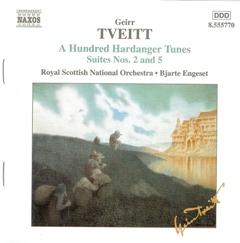Geirr Tveitt - A Hundred Hardanger Tunes (Suites 2 and 5) [2001]
Geirr Tveitt - A Hundred Hardanger Tunes (Suites 2 and 5) [2001]

100 Folk-tunes from Hardanger, Op. 151: Suite No. 2, "15 Mountain Songs": 1. No. 16: Far, far across the fells to Turid 2:57 2. No. 17: With wolves and reindeer in the upland storm 2:35 3. No. 18: Hen, hound, cow and horse - Nursery rhyme 1:03 4. No. 19: Mountain Cattle-call 2:49 5. No. 20: Bringing strong ale up into the mountains 1:29 6. No. 21: Willow flute across the quiet tarn 2:01 7. No. 22: Old Nick, his lament 2:45 8. No. 23: Snow grouse on the Folgafodne glacier 3:34 9. No. 24: Do you hear the song in the waterfall's roar? 1:45 10. No. 25: Lame Lars, his fairy fiddle-tune 1:04 11. No. 26: The song inside Hulder-Hill 3:27 12. No. 27: Beard ablaze 1:53 13. No. 28: Jew's harp melody 0:55 14. No. 29: The mountain girl skiing downhill 1:30 15. No. 30: I saw so far away 5:16 100 Folk-tunes from Hardanger, Op. 151: Suite No. 5, "Troll tunes": 16. No. 61: Troll-tuned Hardanger fiddle 2:11 17. No. 62: Hulder transhumance 1:21 18. No. 63: Hulder hush-a-bye 2:56 19. No. 64: Hulder wedding-breakfast 1:17 20. No. 65: The changeling 3:17 21. No. 66: Folgafodne glacier keeps its secret 2:43 22. No. 67: The boy with the troll-treasure 1:08 23. No. 68: Spell-song 3:14 24. No. 69: The crooked harp that could talk 2:39 25. No. 70: The brownie dancing 2:20 26. No. 71: The water-sprite playing 1:28 27. No. 72: Twilight 1:17 28. No. 73: Fairy flageolet 1:04 29. No. 74: Echo from the other side 3:03 30. No. 75: Doomsday 6:20 Royal Scottish National Orchestra Bjarte Engeset – conductor
Don’t be alarmed, there are certainly not a hundred Hardanger tunes on this CD. In fact there are just 30; all of them beautifully orchestrated. David Gallagher’s informative and witty booklet notes explain that there are four suites in all, each of fifteen tunes. These are numbered 1, 2, 4 and 5. Suite 3 is incomplete and there are sketches for Suite 6. Even so that still does not come to a hundred but never mind.
So what we have are two attractive orchestral suites which use Folk material from the Hardanger Region of Western Norway where Tveitt lived, or which were composed in a folk style. It is impossible to tell which are which and it doesn’t matter, as the style of the music is consistent throughout.
Geirr Tveitt was amazingly prolific. He studied in Vienna and Paris with such composers as Honegger and Wellesz. He retained his strong emotional connection with an area of his native Norway where he spent many a childhood holiday and where he had seen at firsthand the local instruments played and heard the local music. In 1942 he settled permanently with his family in the Hardangerfjord. The CD booklet has a lovely photograph dated about 1954 of the composer in local costume seated with an indigenous instrument rather like a dulcimer.
Sadly a great deal of his music was lost in a tragic fire at this farmstead in 1970. Naxos has recently released the two Piano Concertos, and last summer, Suites 1 and 4. There are also, if you look carefully, discs of his piano music. Nevertheless we shall never know the full extent of his considerable output.
The Hardanger melodies are peculiar to the area; due to the difficult terrain intercommunication between villages and towns was only possible in summer so some tunes and stories were known only within particular families.
Unlike the Suites 1 and 4 mentioned earlier the suites on this CD do not have a narrative running through them but each piece in itself is almost a short story. Realising this, Tveitt gave Suite 2 the overall title ‘Fifteen Mountain Songs’ with individual titles like Mountain Cattle-Call. This is illustrated by gentle string melodies and solo flute. Mountain girl skiing downhill is depicted by a contra-bassoon introduction and a simple three bar melody repeated sixteen times achieving a great climax.
The 5th Suite is entitled ‘Troll-tunes’ with titles such as ‘The Changeling’ (which might remind some listeners of Mussorgsky) and the closing, intimidating Doomsday with its apocalyptic bells.
At times I can hear that Tveitt knew Janacek well, especially in the brass writing. The spaciousness of the music can seem Coplandesque as David Gallagher remarks. I find also that I can hear where Harold Saeverud is coming from, and even, in the block harmonies, Jon Leifs. But one thing I can tell you for certain is that nowhere is the music reminiscent of Grieg.
Naxos here continue their excellent policy of using a conductor and/or orchestra from the composer's country. This has happened whether the music is from Spain (Balada), America (Antheil), Britain (Bax) and I think that this is a very good idea. Of course Music is an international language and you are as likely to come across a superb performance of Elgar by an American or Dutch Orchestra as you are by a British orchestra, but there is also a feeling that with music which is basically nationalist it is wise at least to find a conductor who is ‘in sympathy’ with the repertoire especially when it is as rare as this. Bjarte Engeset cares for and loves this music. The Scottish Orchestra have a natural rapport with the music of the North. Between them they coax this gorgeous music into shape without effort or artificiality. Highly recommended. ---Gary Higginson, www.musicweb-international.com
download: uploaded anonfiles yandex 4shared solidfiles mediafire mega filecloudio nornar
